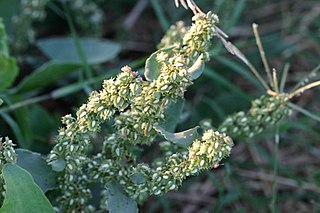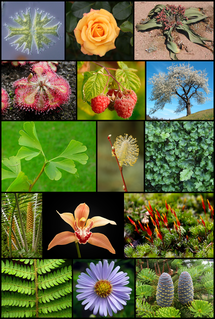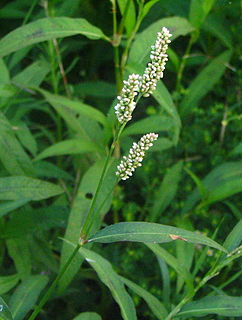
Common sorrel or garden sorrel, often simply called sorrel, is a perennial herb in the family Polygonaceae. Other names for sorrel include spinach dock and narrow-leaved dock. It is a common plant in grassland habitats and is cultivated as a garden herb or salad vegetable.

Persicaria bistorta or Bistorta officinalis is a species of flowering plant in the dock family Polygonaceae native to Europe and north and west Asia. The generic placement of this species is in flux. While treated here in Persicaria, it has also been placed in Polygonum or Bistorta. Other common names include snakeroot, snake-root, snakeweed and Easter-ledges.

Rumex obtusifolius, commonly known as bitter dock, broad-leaved dock, bluntleaf dock, dock leaf or butter dock, is a perennial weed in the family Polygonaceae. It is native to Europe but can now be found in the United States and many other countries around the world such as Australia and New Zealand.

Rumex acetosella, commonly known as sheep's sorrel, red sorrel, sour weed and field sorrel, is a species of flowering plant in the buckwheat family Polygonaceae. The plant and its subspecies are common perennial weeds. It has green arrowhead-shaped leaves and red-tinted deeply ridged stems, and it sprouts from an aggressive and spreading rhizome. The flowers emerge from a tall, upright stem. Female flowers are maroon in color.

Rumex longifolius, commonly known as the dooryard dock or northern dock, is a perennial species of plant in the genus Rumex.

Rumex hydrolapathum, the great water dock, water dock, or giant water dock, is a species of perennial herbaceous plants in the genus Rumex native to fens and freshwater banks of Europe and Western Asia. It is the tallest species in the genus, with flowering stems attaining a height of up to 2 m. It is one of the small number of decaploid organisms, containing two hundred individual chromosomes.

Arctostaphylos regismontana is a species of manzanita known by the common name Kings Mountain manzanita. It is endemic to California, where it is known from the northern slopes of the Santa Cruz Mountains in the southern San Francisco Bay Area.

Rumex stenophyllus is a species of flowering plant in the knotweed family known by the common name narrowleaf dock. It is native to Eurasia and it can be found in parts of North America as an introduced species and roadside weed. It grows in moist and wet habitat, often in areas with saline soils. It is a perennial herb producing an erect stem from a thick taproot, usually measuring 40 to 80 centimeters tall, but known to well exceed one meter. The leaves are up to 30 centimeters long and are generally lance-shaped with curled edges. The inflorescence is an interrupted series of clusters of flowers with 20 to 25 in each cluster, each flower hanging from a pedicel. The flower has usually six tepals, the inner three of which are largest, triangular and edged with teeth, and bearing tubercles.

Rumex brownii, the hooked dock, Browne's dock or swamp dock, is a leafy perennial herb native to Australia, and is widespread and grows in disturbed sites. Introduced weed in Pacific Islands, England, Japan and New Zealand.
Rumex dentatus is a species of flowering plant in the knotweed family known by the common names toothed dock and Aegean dock. It is native to parts of Eurasia and North Africa, and it is widely known elsewhere as an introduced species. It grows in disturbed habitat, often in moist areas, such as lakeshores and the edges of cultivated fields. It is an annual or biennial herb producing a slender, erect stem up to 70 or 80 centimeters in maximum height. The leaves are lance-shaped to oval with slightly wavy edges, growing to a maximum length around 12 centimeters. The inflorescence is an interrupted series of clusters of flowers, with 10 to 20 flowers per cluster and each flower hanging on a pedicel. Each flower has usually six tepals, the 3 inner of which are edged with spinelike teeth and have tubercles at their centers.
Rumex paucifolius is a species of flowering plant in the knotweed family known by the common name alpine sheep sorrel.

Rumex pulcher is a species of flowering plant in the knotweed family known by the common name fiddle dock. It is native to Eurasia and North Africa and it can be found elsewhere, including parts of North America, as an introduced species and a roadside weed. Europe. It is quite variable in appearance, and some authorities divide it into several subspecies that are more or less distinguishable. In general, it is a perennial herb producing a slender, erect stem from a thick taproot, approaching 70 centimeters in maximum height. The top of the plant may bend, especially as the fruit develops. The leaves are up to 10 or 15 centimeters long and variable in shape, though often oblong with a narrow middle in the rough shape of a fiddle. The inflorescence is made up of many branches, each an interrupted series of clusters of flowers with up to 20 in each cluster, each flower hanging from a pedicel. The flower has usually six tepals, the inner three of which are edged with teeth and have tubercles at their centers.

Rumex salicifolius is a species of flowering plant in the knotweed family known by the common names willow dock and willow-leaved dock. It is native to much of western North America and it can be found in parts of Europe as an introduced species and a roadside weed. It is an extremely variable plant which is generally divided into many varieties, some of which may actually be specimens of other species. In general, it is a perennial herb producing a slender stem which is prostrate and spreading or erect, growing up to about 90 centimeters in maximum length. The leaves are up to about 13 centimeters long and can be most any shape. The inflorescence is an interrupted series of clusters of flowers, with up to 20 in each cluster, each flower hanging from a pedicel. The flower has usually six tepals, the inner three of which are largest and usually have central tubercles. It is an important food and host plant for Lycaena rubidus larvae.

Rumex venosus is a species of flowering plant in the knotweed family known by the common names veiny dock, winged dock, and wild-begonia. While not of any particular agricultural use, its cousins rhubarb and buckweat are. It is native to central and western North America, from southern parts of the Canadian prairies, through to Mexico.
Salvia greatae is a species of flowering plant in the mint family, Lamiaceae. Its common names include Orocopia sage and lavender sage.

Torilis nodosa is a species of flowering plant in the parsley family known by the common names knotted hedgeparsley and short sock-destroyer. It is native to parts of Europe, especially the Mediterranean Basin and it is known elsewhere, such as North America, as an introduced species and a common weed. It grows in many types of habitat, particularly disturbed areas. It is an annual herb producing a hairy stem up to half a meter in maximum height. The alternately arranged leaves are each divided into several pairs of smooth-edged lance-shaped or linear leaflets. The inflorescence is a dense compound umbel of flower clusters on very short rays, often appearing like a cluster. Each flower has five petals which are unequal in size and are white with a pinkish or reddish tinge. Each greenish or pinkish fruit is about 3 millimeters long and is coated in long prickles.

Rumex arifolius, common name maiden sorrel or mountain dock, is a leafy perennial herb in the family Polygonaceae.

Rumex alpinus, common name monk's-rhubarb, Munk's rhubarb or Alpine dock, is a leafy perennial herb in the family Polygonaceae. It is native to upland areas of Europe and Western Asia.

















